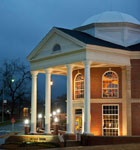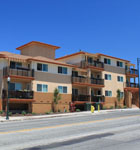A key to selling a niche product or service is gaining access to the market’s biggest fish. In its early days, Rolls-Royce found an entire second source of revenue building engines for major airplane manufacturers. Chapman J. Root made millions for his own business by selling the design for a curvy glass bottle to Coca-Cola. And, Florida-based Aquatic Design & Engineering, Inc. (ADE) earned its industry renown doing work for Walt Disney World, which owns more pools in the Sunshine State than anyone else. From that collaboration, ADE has broadened its geographic reach, and its skill set has grown from pools to massive aquatic projects. The firm has learned the business strategies necessary to earn work such as the impressive Welcome Pavilion Fountains fronting Ferrari World theme park in Abu Dhabi, UAE, but it has also learned the challenges of expansion and of achieving its standard of quality construction outside the United States.
From Pools to Pageantry
CEO Ken Martin founded ADE in 1987, but his experience in large-pool construction actually spans 40 years. Today he oversees operations alongside his son Josh, a 28-year-old entrepreneur and the firm’s COO, who will transition into his father’s role in three years so that Ken can concentrate on what has always been his industry forte: engineering groundwork. The pair of them put in thousands of miles flying to aquatic features and commercial pool projects abroad, in other states, and at home in Orlando.

Disney World noticed Ken’s firm in the 1990s. “Back when Disney was really developing their theme parks and all the hotels on site and various pool complexes that supported each hotel, they needed good talent,” he says. ADE not only had some of the best aquatic design engineers in the world; it’s headquarters happened to be just a 20-minute drive from Disney property. Partly because of this advantage, ADE won bids and designed 100 pools for the popular vacation destination. And when the area’s high-end hotels began to notice this work, the firm ended up writing design standards for the aquatic facilities of many national hospitality chains as well.
It was at this point that Ken started to look beyond the swimming pool toward a more rarified sector. His firm jumped into work on large-scale aquatic features, a term often referring to fountains—and not just any fountains but the kind that feature lights, colors, and choreographed movement set to music—and today ADE is highly regarded for creating complex water displays. More than plotting the curve of a pool’s edge or the arrangement of a fountain’s nozzles, ADE has to conjure designs that delight and enthrall. “We have to create something that’s going to be just doggone entertaining,” Ken says, citing smart phones and other portable distractions as competitors for spectators’ attentions.
The strategy ADE employs to win such high-profile national and international projects essentially boils down to meeting and impressing the people who are already at the party. By targeting world-class architectural or landscape architectural firms already working in specific areas and obtaining their recommendation to be brought onto projects, ADE sidesteps the almost-impossible task of sitting down personally with a client—who could be anyone, including the head of a multibillion-dollar company or the leader of a country. And ADE only garners recommendations from a job well done, of course: “We believe that if we can work with any firm one time,” Josh says, “they will absolutely want to come back and work with us again.” This is how the firm has earned continuing work in the United Arab Emirates (UAE).

Bringing Water to the Desert
ADE used to have an office in Dubai, UAE, the wealthy, oil-producing Middle Eastern emirate known for its rocket-speed growth and wild, fantastic building designs. Case in point: Dubai is or will soon be home to a gigantic Egyptian-style pyramid hotel, a giant sphere aptly named the Death Star, and a module skyscraper with each of its 80 stories in constant rotating motion.
Today, however, ADE’s UAE office is located in nearby Abu Dhabi. This emirate has also worked aggressively to bring in designers for buildings no less shocking to the senses—including a nearly 400-foot circular skyscraper and the proposed translucent bird’s wing that will be the new performing arts center—but there was a steadier long-term focus in Abu Dhabi that appealed to ADE.
By the Numbers: The Welcome Pavilion Fountains
30 million
the amount of water in gallons that moves through the Welcome Pavilion Fountains’ nozzles at any one time
750
the number of nozzles pumping water through the fountains
3.5
the length, in minutes, of the fountains’ light-infused evening shows and splashy, nozzle-driven daylight sequences, controlled by the fountains’ active-mode programming
30
the elevation change, in feet, from the top fountain to the bottom fountain, including eight stepped weirs of roughly three feet each and a final 15-foot, cascading waterwall
70-100
Abu Dhabi’s year-round high temperature in degrees Fahrenheit; in addition to providing entertainment, having water cascade down the aquatic feature’s weirs during daytime sequences helps prevent the water from evaporating off of the pools’ surfaces on hot days
90,000
the combined square footage of the two fountains, making the water feature the biggest one in the city of Abu Dhabi
Abu Dhabi’s Yas Island lies just east of the emirate’s peninsular center. The small island is home to an IKEA, a flashy marina, and a golf course, but when flying overhead, all these structures are small and quaint compared to the massive, claw-footed bright red structure bearing Ferrari’s trademark cavallino rampante logo. Ferrari World, an indoor theme park boasting the largest roof in the world (2,152,782 square feet), is also home to one of ADE’s latest projects: the Welcome Pavilion Fountains.
Jets of water—there are more than 750 nozzles—leap neatly from eight-stepped ponds, chasing one another in a swirl-patterned game of tag. At night the jets stand out in brilliant color projected from LED lights while backlit water cascades down the weir edges to form crisp waterfalls. There are five unique vantage points from which to watch the show, including a hidden underground VIP dining terrace with an exclusive view of a 20-foot waterwall that crashes down around the space. The entire aquatic feature, which is in fact two separate features straddling Ferrari World’s translucent, turtle shell-like Welcome Pavilion, occupies 90,000 square feet. It is the largest fountain in Abu Dhabi to date (ADE is currently working on an even larger one in the emirate, to be completed in three years).
International projects, which made up 70 percent of ADE’s workload last year, have their own unique set of challenges. Twenty years ago, Ken took a flight down to Puerto Rico to meet a client and watch workers break ground on a massive aquatic feature he had designed. “They were supposed to be placing concrete that day,” he says, “and I saw a pickup truck pull up … to the job site. And a couple of people were on it, and they had bags of cement and shovels full of sand, and they started mixing the cement themselves.”
He learned right then that you can’t count on the standards or available technology in Puerto Rico, the Caribbean, or China to match what contractors are accustomed to in the United States. There are also local customs that change how the work is completed, a whole separate set of building codes, a metric system that complicates the feet-and-inches mind-set of an American company, and workers who have never even seen a fountain before. “Our drawing package is almost an assembly package,” Josh says. And, his father adds, “Our drawings literally have to reflect exactly what a completed feature will look like.”
The Martins employ the words “blessed” and “fortunate” more times than one can count, but they never say, not once, “lucky” to describe how ADE has risen to the top two or three aquatic-design firms in the world. By surpassing spectators’ imaginations with projects from Disney World to Macau, China, delivering data its clients don’t even know they need, and getting “the right people in the right seat on the bus” (to quote Josh, paraphrasing the entrepreneur Jim Collins), ADE has made its own luck. ABQ




